Chapter: 11th Home Science : Chapter 5 : Nutrition
Water Soluble Vitamins: Functions, Food sources, Deficiency
Vitamins
Fat soluble vitamins A, D, E and K and also water-soluble vitamins C and B group are found in foods. These are needed for growth, normal function of the body and normal body processes.
Water Soluble Vitamins
(a) Thiamin (B1):
Thiamin is the first member of the B complex vitamins which is essential to the body in its coenzyme form.
Functions: The coenzyme of thi-amin is Thiamin Pyro Phosphate (TPP). Thiamin is useful in our body for the following functions
· It enhances growth in human beings.
· It plays an important role as a coenzyme in carbohydrate metabolism
· Maintenance of nerves in nor-mal condition.
Food sources: Good food sources include lean pork, beef, liver, whole or enriched grams and legumes.
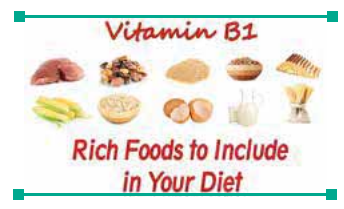
Deficiency of thiamin: The dis-covery of thiamin provided the answer to the puzzle of a nutri-tional problem called beri beri. The deficiency of thiamin causes beri beri in human beings. The Philip-pino word beri beri means “I Can’t” refers to the lack of neuromotor coordination in persons with the disease.
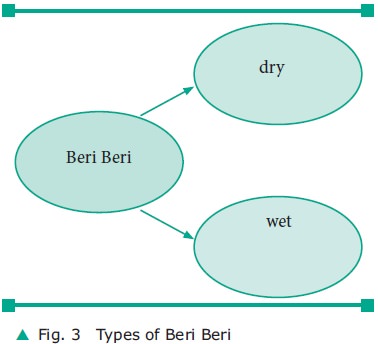
Beri Beri is of two types: dry and wet type. In dry beri beri the mus-cles become progressively wasted, weak and walking becomes dif-ficult. If not treated the patient becomes bedridden and will die. In wet beri beri edema is present which involves the face, trunk and serous cavities. Palpitation and breathless-ness are present. The heart becomes weak and death occurs due to heart failure. Infantile beri beri is seen in many South East Asian countries where the diets consist mostly of “polished rice”.

(b) Riboflavin (B2):
Riboflavin is a sta-ble vitamin which is resistant to acid, heat and oxidation. But it is unstable in the presence of alkali and light.
Functions:
The two coenzymes of Riboflavin Flavin Mono Nucleotide (FMN) and Flavin Adenine Dinucleo-tide (FAD) perform the following functions
· Formation of red blood cells in the bone marrow.
· Regulates the functions of hor-mones in carbohydrate metab-olism.
· Present in the retina in the free form which gets converted to a compound which stimulates the optic nerve.
· Release of energy from glucose, amino acids and fatty acids.
Food sources: Good sources of riboflavin are milk and milk prod-ucts, eggs, liver, whole or enriched grains and green leafy vegetables.
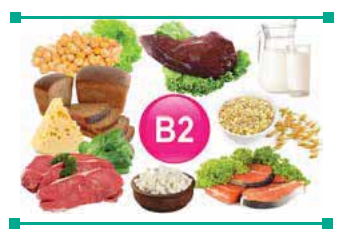
Deficiency: The deficiency of riboflavin (ariboflavinosis) leads to glossitis (swollen and reddened tongue), swollen lips, cheilosis (inflammation of the corners of the mouth, are some of the com-mon symptoms observed. Further deficiency states are marked by chronic conditions like tubercu-losis, prolonged fevers, malab-sorption, Hyperthyroidism and malignancy.
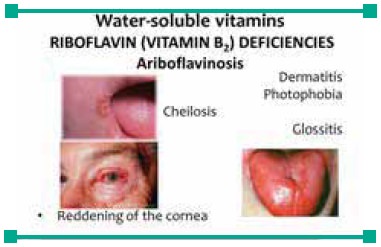
(c) Niacin:
Niacin formerly known as nic-otinic acid was obtained by the oxida-tion of nicotinic acid. Apart from the food sources, Niacin is also obtained from tryptophan (60mg) an essential amino acid which can be converted into niacin (1mg).
Functions: Two coenzymes of Nia-cin Nicotinamide Adenine Dinu-cleotide (NAD) Nicotinamide Adenine Dinucleotide Phosphate (NADP) are required for:
· Release of energy from all energy yielding nutrients like carbohydrate, protein and fat.
· Normal functioning of the skin, intestinal tract and the nervous system.
· Synthesis of protein and fat for the formation of DNA and RNA.
Food sources: Whole cereals, pulses, nuts and meat are good sources of Niacin. Groundnut is rich in Niacin. Milk is rich in Tryp-tophan the precursor of Niacin in the body.
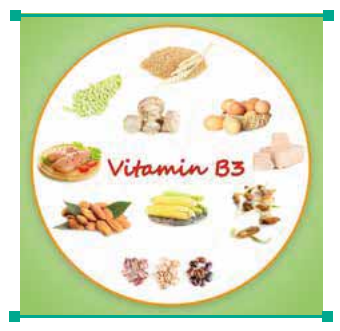
Deficiency: Deficiency of Niacin causes Pellagra which is the 3D (Dermatitis, diarrohea, dementia or depression) disease leading to the fourth D (Death).
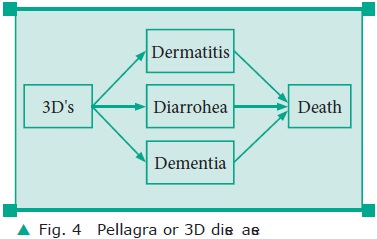
Consumption of diets rich in corn can create amino acid imbalance as corn is rich in leucine and deficient in tryptophan. The typical features of pellagra are loss of weight and increasing weakness. Non- specific signs like anorexia, nausea, diges-tive disturbances and emotional changes like anxiety, irritability and insomnia may be present.

(d) Pyridoxine (B6):
Pyridoxine exists in the body in three forms: Pyridoxal, Pyridoxine and Pyridoxamine. Pyri-doxal 5 phosphate is the co-enzyme form of pyridoxine.
Functions: Pyridoxal 5 phosphate acts as a coenzyme in protein metabolism. Its functions include
· Amino acid transport.
· Essential for the growth of infants.
Food sources: Good food sources include grains, seeds, liver, kidney and other meats.
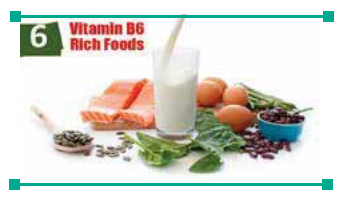
Deficiency: Clinical Symptoms of pyridoxine deficiency have not been clearly defined. Some types of angular stomatitis (cracking at the corners of the lips) and cer-tain types of anaemia have been reported due to decreased intake of pyridoxine.
(e) Folic acid:
The term folic acid was coined to as it was first extracted from dark green leafy vegetables such as spinach.
Functions: The different func-tions of folate include:
· Normal growth and division of all cells.
· Maturation of red blood cells.
· Vital role in the metabolism of some amino acids.
Food sources: The rich sources of folate are fish, mutton, liver, egg, chicken, green leafy vegetables and pulses.

Deficiency: Deficiency of folic acid causes megaloblastic anae-mia. Megaloblasts appear in bone marrow and peripheral blood. Poor dietary intake of folic acid, low absorption, increased losses, increased requirements, infes-tation, infection and drugs also cause folic acid deficiency. Symp-toms include weakness, tiredness, dyspnea, sore tongue, headache and palpitation. Folate deficiency during pregnancy can result in neural tube defects like spina bifida and anencephaly.
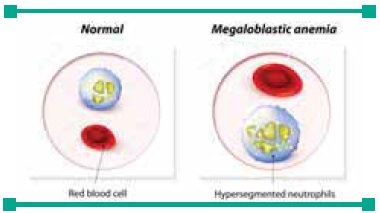
(f) Cyanocobalamin (B12):
The vitamin is named as cyanocobalamin because of the presence of cobalt and cyanide in its structure. It can be absorbed in the body only in the presence of Intrinsic Factor (IF).
Functions: Physiological func-tions and biochemical functions of cyanocobalmin are:
· Maturation of erythrocytes
· Synthesis of myelin (white sheath of lipoprotein) that sur-rounds many nerve fibres.
· Increase in White Blood Corpus-cle (WBC) count and platelet.
· Stimulation of appetite and general wellbeing of the people.
· Cures neurological symptoms of pernicious anemia.
Food sources: Cyanocobalmin is synthesized by bacteria and is found in foods of animal origin. Liver is the richest source of cya-nocobalmin. Meat, fish, kidney, brain and eggs are good sources of cyanocobalmin.
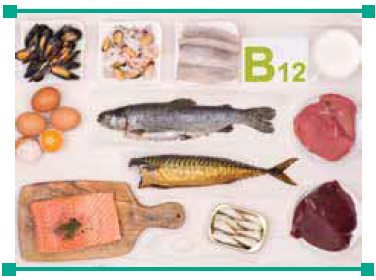
Deficiency: Inability to produce the intrinsic factor which binds cyanocobalmin leads to perni-cious anemia. The red blood cells are macrocytic and the count is often less than 2.5 million. Symp-toms include soreness and inflam-mation of the tongue, paresthesia (numbness and tingling) in fingers and toes, demyelination of the white fibres of the spinal cord and in severe cases degeneration of the spinal cord.
Other B complex vitamins include biotin, pantothenic acid which do have their vital functions as coen-zymes in various biochemical func-tions of the body
(g) Vitamin C (Ascorbic acid):
Ascorbic acid is the chemical name of vitamin C which can be synthesized from glu-cose but humans depend on their diet for vitamin C as they do not have an enzyme gulonolactone oxidase which catalyzes the conversion reaction.
Functions: Functions of vitamin C include:
· Collagen formation of bone, teeth, cartilage, skin and scar tissue.
· Formation of dentin layer of tooth
· Wound healing.
· Activation of calcitonin, gas-trin, oxytocin, thyrotropin, vasopressin.
· Drug detoxification
· Regulation of cholesterol, maintenance of the blood ves-sel structure and antioxidant effects.
· Conversion of inactive form of folic acid into its active form
· Reducing agent to keep iron in its ferrous form to facilitate iron solubility.
· Adrenal cortex function.
· Enhances calcium absorption.
Food Sources: Citrus fruits like orange, lemon, tomatoes, guava, watermelon are good sources of Vitamin C

Deficiency: Scurvy the most severe form of vitamin C deficiency arises mainly due to faulty cooking habits and inadequate intake of fruits and vegetables. The clinical features of scurvy are characterized by gin-givitis (bleeding gums) petechiae (small hemorrhagic spots), arthral-gia (pain in the joint), depression, postural hypotension, delayed wound healing. Main deficiency symptoms in infants include tender bones, cessation of bone growth, anaemia and pyrexia.

Related Topics